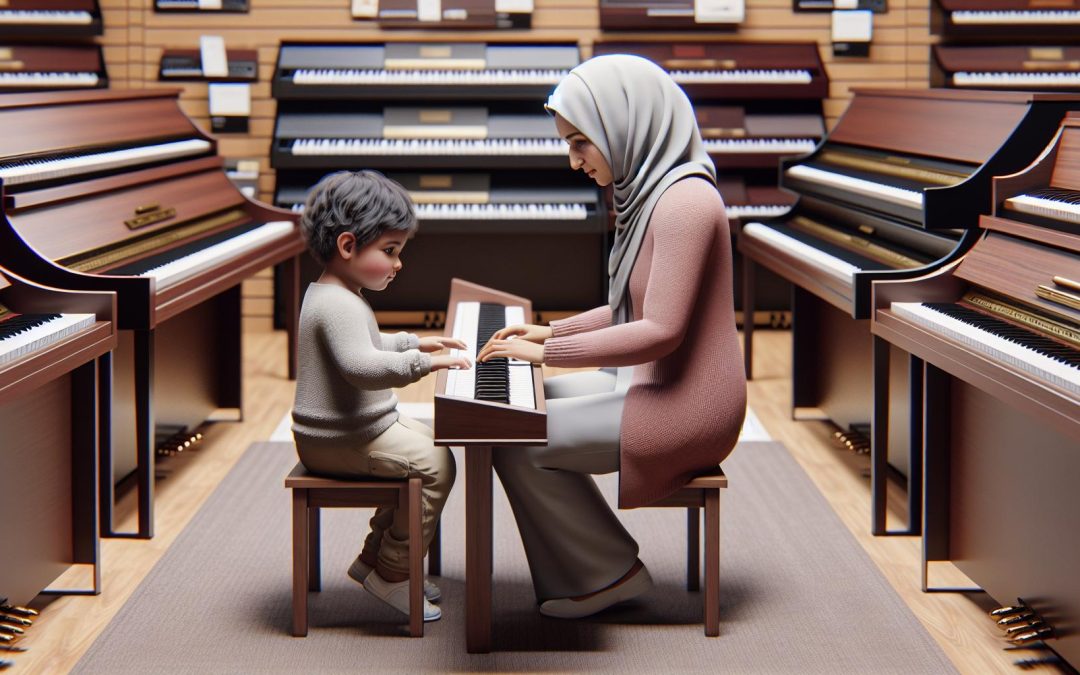Choosing the right piano keyboard for kids can seem like a daunting task. With so many options out there, it's easy to feel overwhelmed. But don't worry, we're here to help make the process a little easier.
The key is to find a balance between a kid-friendly design and high-quality sound. You'll want something that's durable enough to withstand a child's enthusiastic playing, but still offers a good range of notes and tones.
Factors to consider when selecting a piano keyboard for kids
Choosing the right piano keyboard for kids can seem like a daunting task. The market is inundated with options, each boasting unique features and benefits. However, by taking a systematic approach and considering a few key factors, you'd be able to make an informed and beneficial choice for your child.
Size and Keys
A keyboard that's suited to your child's size and strength is crucial to their learning process and enjoyment. The number of keys on a keyboard - which can range from 25 to 88 - can significantly affect your child's playing experience. For beginners, a 44 or 61-key keyboard is typically suitable, offering enough variety in notes without becoming overwhelming.
Sound Quality
While it's tempting to opt for the most colorful, kid-friendly design, sound quality should never be compromised. Look for a keyboard that mimics the tonal richness of an acoustic piano as closely as possible. Yamaha's and Casio's children's models are reputed for their quality of sound.
Durability
Let's face it - kids can be tough on their toys. The keyboard you choose should be well-built to withstand a child's enthusiastic playing. A sturdy construction combined with splash resistance will go a long way in increasing the keyboard's lifespan.
Educational Features
The integration of educational features, like built-in lessons, lighting keys, or interactive games can make learning more engaging and fun for your child. Models like the Yamaha EZ-220 and the Casio LK-265 excel in this area, offering interactive learning experiences.
Price
Price is a factor one cannot overlook. Child-friendly keyboards don't have to be expensive, but it's essential to not compromise on the aforementioned factors in pursuit of a bargain. It's always better to consider it an investment for your child's musical journey.
Take a moment to reflect on these factors before selecting a keyboard. Stay tuned for more tips and consider these factors to make the best choice, and you'll ensure a positive learning experience for your young pianist.
Size and weight of the keyboard

A crucial consideration when hunting for the perfect piano keyboard for children is size and weight.
Size refers not only to the dimensions of the keyboard but also to the number of keys. Piano keyboards generally come in three main sizes:
- 25 keys (2 octaves)
- 49 keys (4 octaves)
- 61 keys (5 octaves)
25- key keyboards are well-suited for toddlers and small kids, offering an easy introduction to music. They're usually lightweight and easy for little hands to navigate.
Moving up, 49-key keyboards are a fantastic all-rounder choice for older kids. They provide a broader range of notes allowing for more complexity in music. Plus, their size still makes them manageable for transportation.
Lastly, the 61- key keyboards are for the serious young musician. They mirror a full-size adult keyboard and are ideal for older children who've already shown a real knack for pounding the old ivories.
When it comes to weight, it's key to keep in mind the child's age and strength. If the kid needs to schlep the keyboard to lessons, it should be light enough for them to carry. For stationary home use, a heavier, more robust model may be a better option.
Choosing a keyboard of appropriate size and weight can make a significant difference in a child's learning experience. A too large or heavy keyboard could seem intimidating and hamper their enthusiasm to play and learn. Similarly, a too small or light keyboard might limit their musical expression.
Above all, remember that the perfect keyboard is the one that makes your child happy to play on. Let them try different sizes and see which one they're comfortable with. Remember: this is about fostering a love for music, not forcing a professional pursuit.
Number of keys on the keyboard
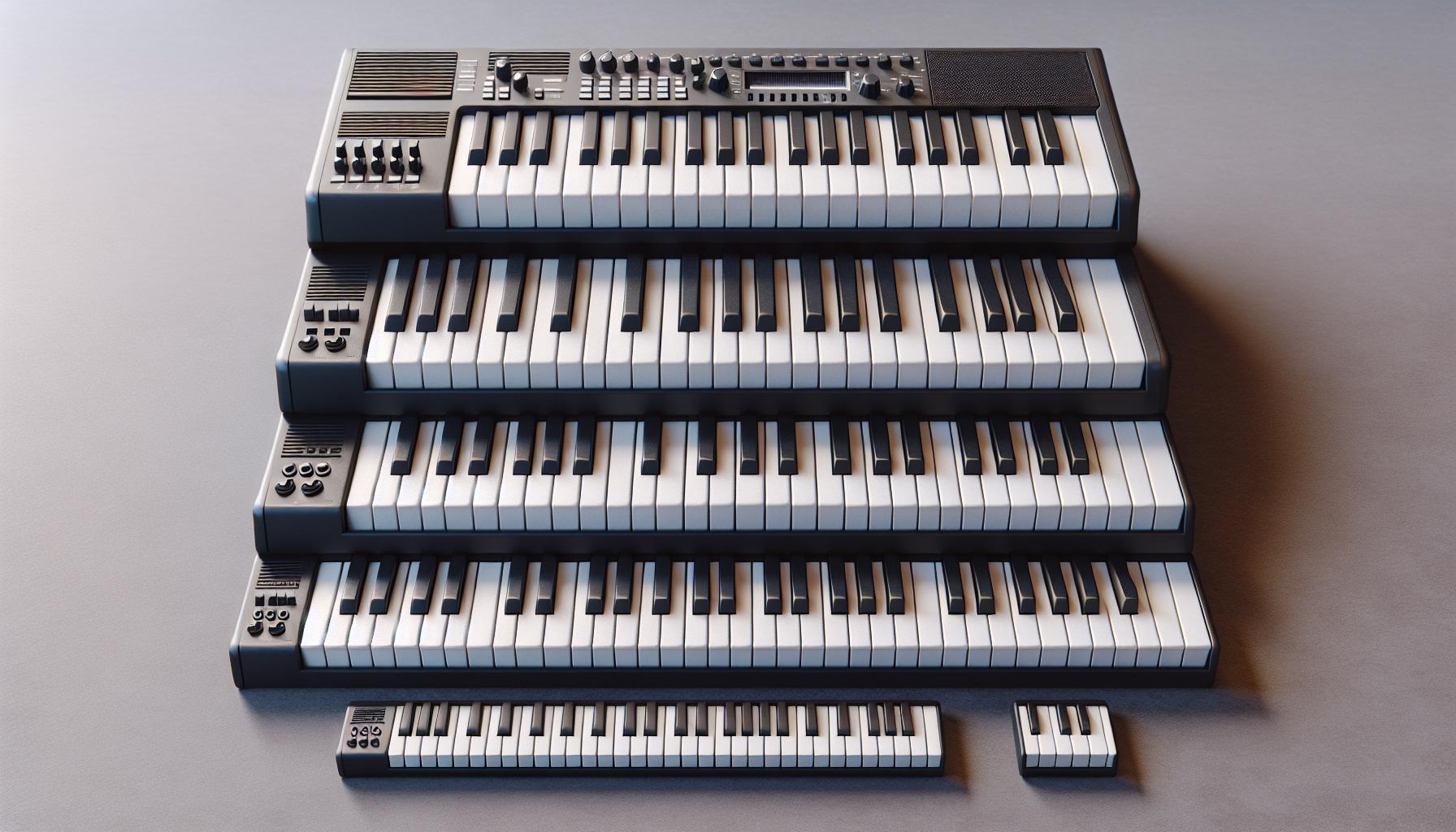
When choosing a keyboard for your little Mozart, the number of keys is a crucial factor to consider. Piano keyboards typically come in three main sizes: 25 keys (2 octaves), 49 keys (4 octaves), and 61 keys (5 octaves). Let's delve a bit more into each size and discover how they might relate to your child's musical journey.
25-Key Keyboard
A 25-key keyboard is often the preferred choice for beginners and very young children, especially those under the age of six. These smaller keyboards are not as overwhelming and offer a great introduction to basic musical concepts. Kids can still learn the essentials of playing, such as identifying keys, developing a sense of pitch, and understanding rhythm.
49-Key Keyboard
Moving up in size, the next option is the 49-key keyboard. This keyboard size is well-suited for children aged six to nine, who might have already grasped some basic musical concepts and are ready for the next challenge. With four octaves, kids can explore a wider musical range without feeling overwhelmed by an enormous number of keys.
61-Key Keyboard
For the more advanced young pianists, or those above the age of nine, a 61-key keyboard might be the perfect fit. This size offers a wide range of five octaves, which allows kids to play more complex pieces. It also accommodates growing hands and provides the chance to become acquainted with the full keyboard layout that musicians encounter on a regular grand piano.
In the end, it's important to keep in mind that the keyboard should match the child's size, age, and skill level. A too-large keyboard might overwhelm a youngster while a too-small one might limit an eager pianist. Don't forget, the objective isn't to create a professional pianist overnight. It's about fostering a love and understanding of music.
Types of keyboards available for kids
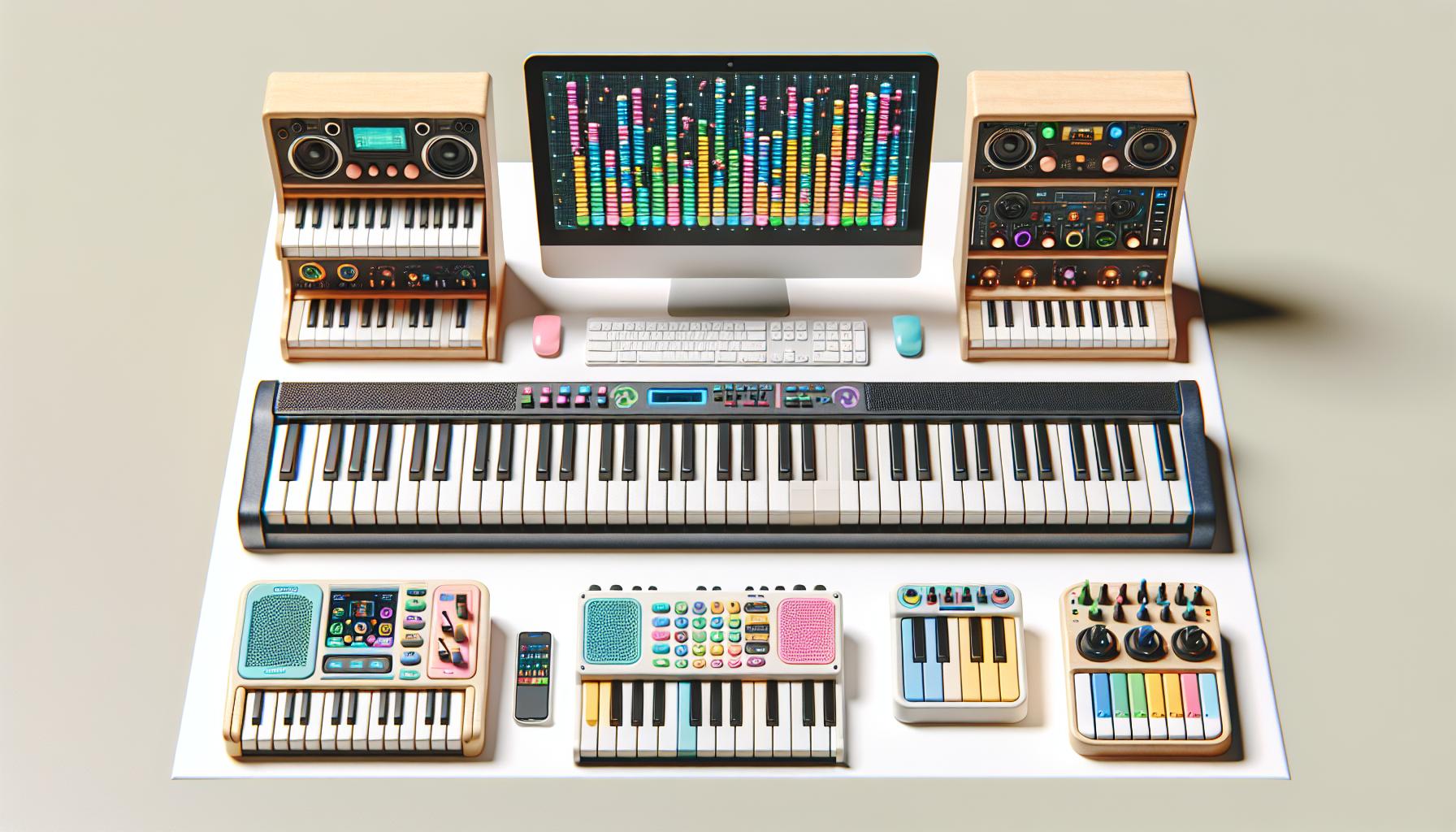
Having already discussed the variations in size and weight of keyboards for youngsters, let's delve into the different types of keyboards available for kids. Whether a child is just starting out or has been practicing for a while, there's a keyboard designed to cater to their specific needs.
Portable Keyboards are a popular choice due to their affordability, lightweight designs, and ability to be packed up and transported easily. They usually come with a range of built-in sounds and rhythms that can make practice sessions more enjoyable for kids.
Stepping up from the portable keyboards, we have Digital Pianos. These are designed to mimic the sound and touch of an acoustic piano. While they may be heavier and higher in price, they offer an exceptional learning experience with their weighted keys helping to develop proper finger strength and technique.
Synthesizers offer the chance to create and adjust sounds, perfect for those young music explorers. They're usually more advanced and maybe a little tricky for beginners, but for a child who's shown a knack for tinkering with and crafting unique sounds, a synthesizer is the way to go.
Then we have Workstations, which are like the all-in-one packages in the world of keyboards. These have it all: high-quality sounds, in-built lessons, recording capabilities, and even space for scripting original compositions. If you have a serious young musician in your house, a workstation could be a fantastic investment.
Lastly, there's the MIDI keyboard. This doesn’t produce sounds by itself but connects via USB to a computer where sounds are generated. The sounds can be customized starting from pianos to synthesizers to drums. This is an excellent choice for budding music producers.
Above all, remember - the best keyboard is the one that aligns with the child's interest and future growth in music. There're still a lot more to discuss but for now, this should give a good foundation. The subsequent part of this guide will be focusing on some essential features you need to look for in a child-friendly keyboard.
Sound quality and technology features
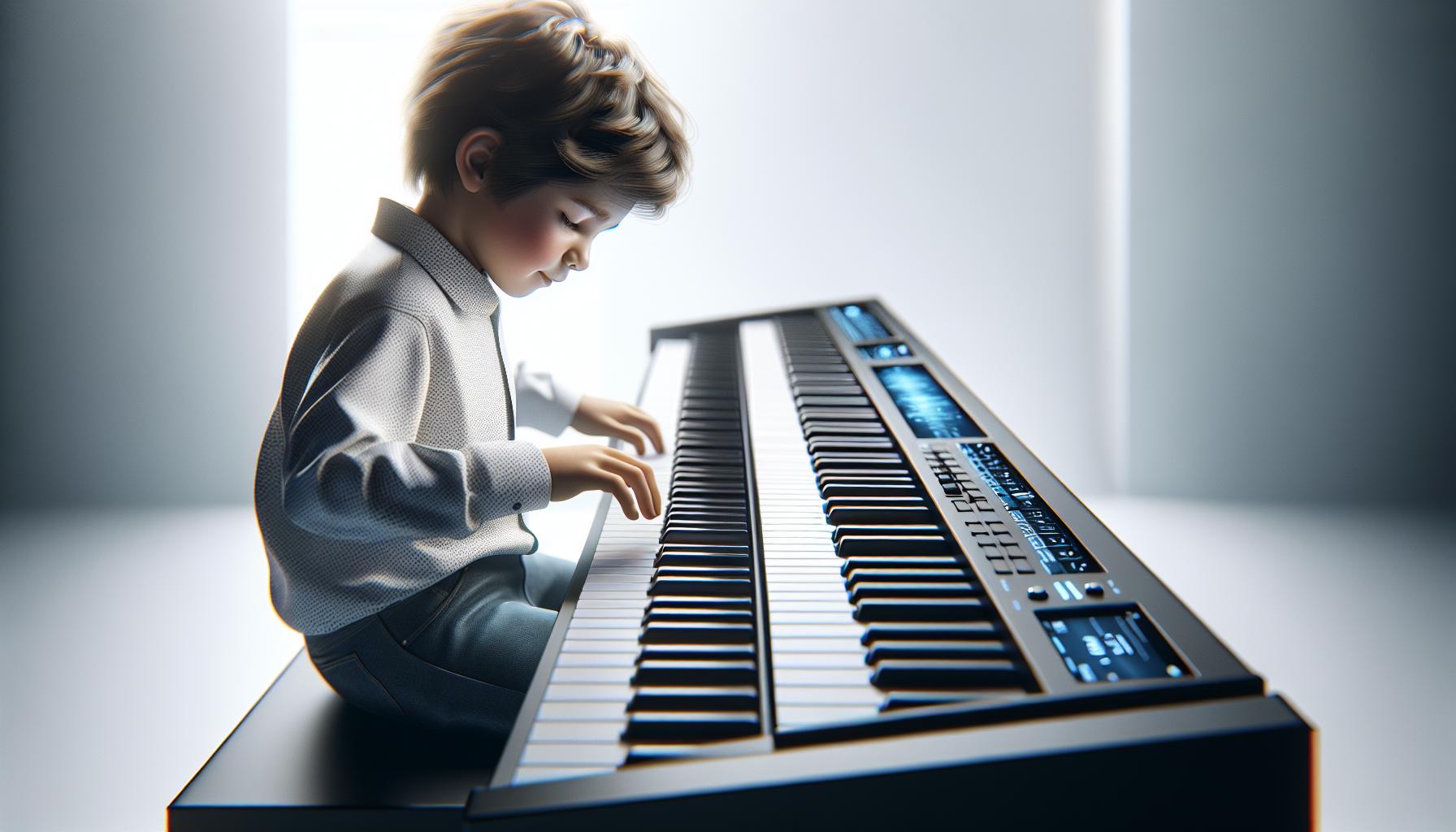
Focusing on the size and weight of a keyboard is quite essential when it comes to choosing a keyboard for kids. That's pretty clear now. But let's not overlook another major characteristic that plays a vital role in this buying guide - Sound quality and technology features of the keyboard.
In the world of digital pianos and keyboards, each model boasts unique sound quality. This sound portrayal stems from behind-the-scenes technology that works to mimic the tonal qualities of a traditional acoustic piano. For instance, sampled sounds form a significant part of many keyboards, and they are created by recording actual instruments. This technology helps young musicians get a taste of different instrument sounds without owning each of them.
Besides, children who harbor a fondness for various music genres might appreciate keyboards with in-built rhythms, music styles and tones. These features can inspire creativity and open a new vista of musical exploration for them.
On the flip side, if your child is specifically gearing up for traditional piano lessons, a digital piano with weighted keys and a handful of realistic piano sounds would be fitting. Aspects like touch sensitivity, polyphony (the number of sounds a keyboard can produce simultaneously) and weighted keys, are technicalities inherent in these pianos. These enhance the sound quality, offering an experience which is as close as possible to playing an acoustic piano.
Certainly, a world of innovative technology in this sphere is now available. From USB connectivity and built-in metronomes to learning modules and recording capabilities, various tech-friendly features invite young users to explore and express their musical capabilities in a whole new light.
Music aficionados contend that while technology has its place, it's the resonance that counts. They look for a well-rounded tone that reproduces the rich, complex sound of an acoustic piano.
Ultimately what matters is the child’s personal preference - it’s often wise to involve kids in the decision making. That way, they'll be more invested in learning and likely to stick to practice. After all, a child who enjoys their time behind their piano keyboard is more likely to be a lifelong music lover.
Budget considerations
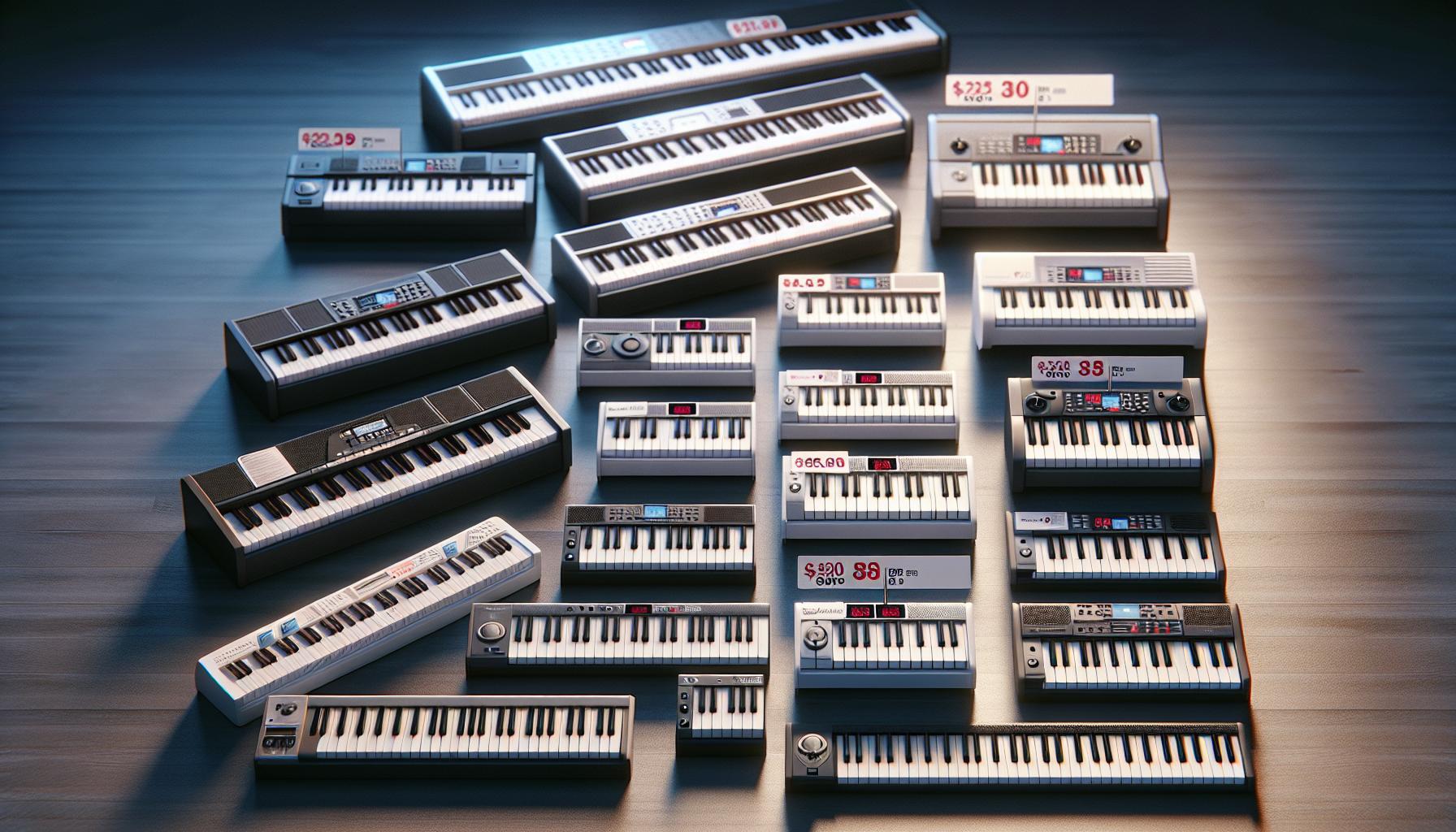
Once you've figured out the right size, weight, and technical features, the next major factor to consider is your budget. Just like guitars and drums, piano keyboards come in a range of prices, catering to different budget levels. However, the truth is you get what you pay for. Generally, if you're willing to invest a bit more, you'll find keyboards with better sound quality, durability, and more advanced features.
But don't get discouraged. There are affordable options available too. If you're shopping for a keyboard for a young beginner, something basic and relatively inexpensive should work fine. You don't want to break the bank on a lavish keyboard when they're just getting their feet wet. They could lose interest or move on to another instrument, and that's okay!
When determining your budget, consider the longevity of the instrument. A cheap keyboard might suffice in the early learning stages, but as the child progresses, they'd appreciate a higher-quality keyboard. For beginners, it's reasonable to start with a cheaper model and consider upgrading as their skill and interest increase.
Bear in mind, higher-priced keyboards tend to come with more advanced features, like USB connectivity, better sound sampling, and highlighting keys. While you want to motivate your child with advanced technology, these are not always necessary for beginners.
At the end of the day, the best keyboard is the one your child will use the most. Whether that's a $50 keyboard or a $500 digital piano, the value lies in the versatility and how much the child enjoys playing it. As long as they're excited to play and are learning the basic skills, any keyboard within your budget will work just fine.
One way to get a better deal is to wait for holiday sales, or check second-hand options. Used keyboards can be an economical solution, given they're in good working condition. Just be sure to test it or have it tested before buying.
Conclusion
Choosing the right piano keyboard for your child doesn't have to be a daunting task. It's all about finding balance - between the child's age and skill level, the keyboard's features and price, and the instrument's longevity. Remember, it's not always about the priciest or the most technologically advanced model. It's about what suits your child best.
So, take your time. Weigh your options. Don't shy away from starting small and upgrading later. And always keep an eye out for a good deal. With a little patience and a lot of love, you'll find the perfect keyboard that'll help your child hit the right notes in their musical journey.
Harlan Kilstein began playing piano during covid with no piano background at all. He taught himself how to play learning what to do and what not to do.
Today he's an advanced intermediate player and can help you grow in your skills because he learned all this on his own.

